Where to Find Specialty Coffee in Rome (for Coffee Nerds)
I distinctly remember being at a cafe in Paris (that shall remain unnamed) chatting with the barista a few years back about the coffee scene in Rome.
I said something to the effect of “I probably won’t be drinking as much good coffee as I am here” and they guffawed and remarked that I would probably be drinking zero good coffee while I was in Rome.
And, while that’s an extreme characterization of Rome’s coffee scene, it certainly is true that the specialty coffee scene in Rome is significantly less developed than cities in Spain, France, Portugal, and especially northern European countries.
Coffee leans more towards the “single espresso at the bar with TONS of crema” side of the spectrum than I personally prefer.
However, different doesn’t necessarily mean worse, which is an idea I tried to communicate to said barista.
There is undoubtedly something charming about that espresso at the bar experience that I have never, ever gotten close to at cafes here at home. While this guide will largely focus on “specialty” coffee, it is absolutely worth putting aside the search for the “best” coffee to soak up that unique aspect of Italian coffee culture.
However, that’s not what this guide is about, though I do have a couple of suggestions for you below around where to go for fun old-school cafe experiences.
This guide is about Rome’s specialty coffee scene, which has come a long way since my first visit more than a decade ago, when there were essentially two places to find coffee that wasn’t a blend of arabica and robusta pulled in a single shot.
Since that first visit, when I was early in my coffee journey (I was still using a Keurig at that point) and made the stereotypical mistake of ordering a “latte,” which the barista laughed at before seemingly giddily serving me a glass of steamed milk, I have been to Rome four more times, including two visits of over a week in the past few years.
Over that time, the specialty coffee scene in Rome has exploded. And, to be clear, by exploded, we mean that it has gone from one or two places to too many places to count on one hand, which represents a huge increase!
There’s now a roaster that focuses on light roast coffee designed for filter, at least five places to get great specialty coffee (even filter!), and more and more places thinking harder about their coffee offerings.
Now, is Rome’s specialty coffee scene on the same level as, say, Paris, Amsterdam, or Madrid? Definitely not. But compared to where it was a decade ago, it has come a long way!
In this guide, I’ll take you through my favorite places to get great (specialty) coffee in Rome based on my own experiences exploring the city.
Sound good to you? Let’s get into it.
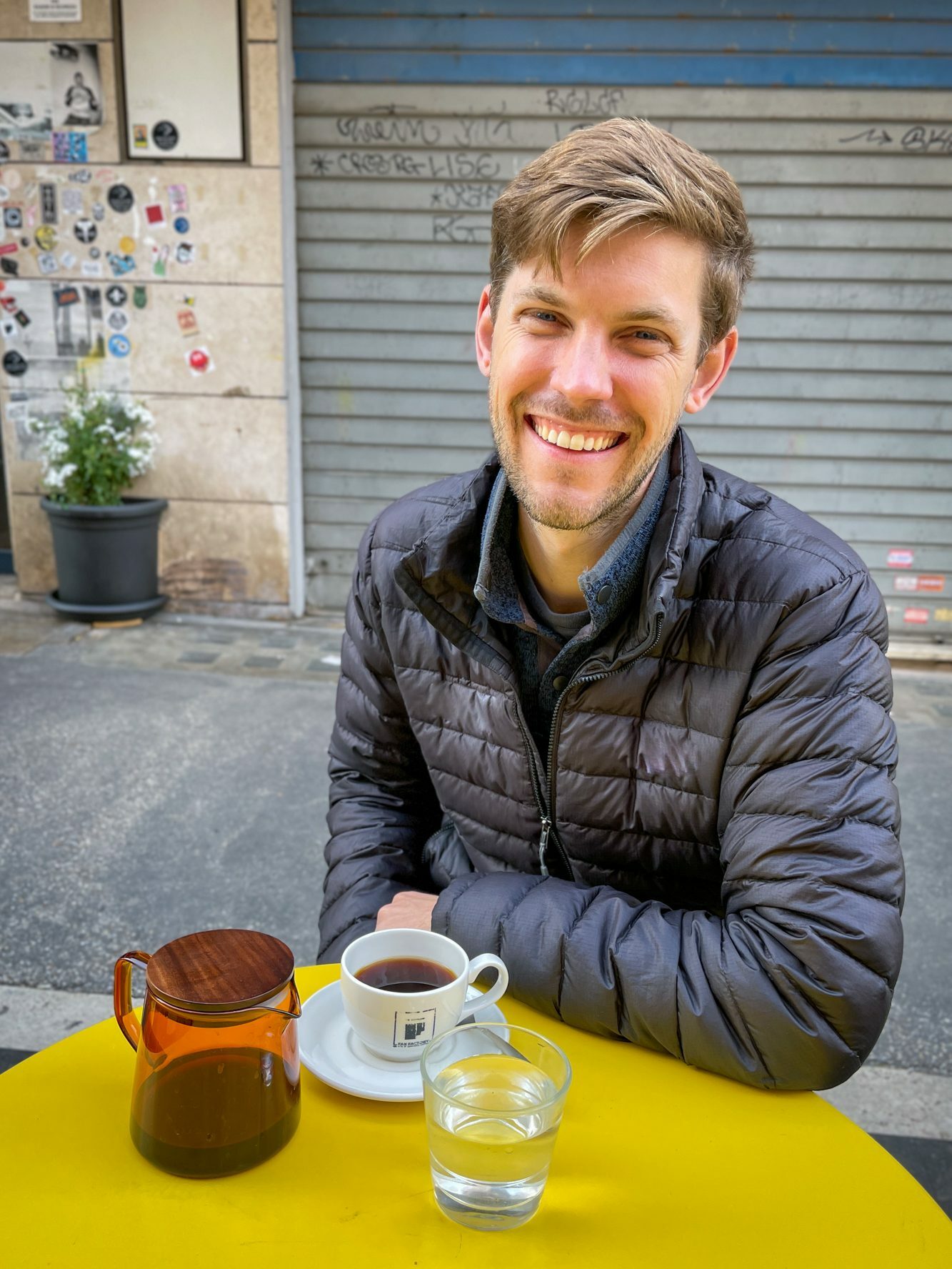
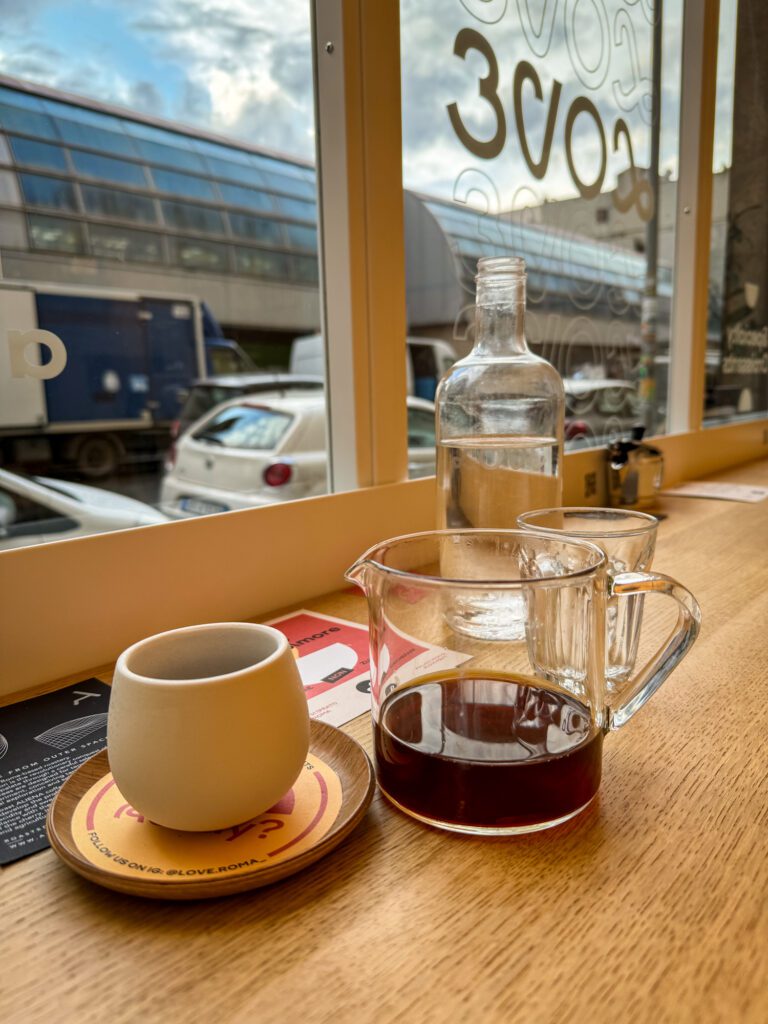
Disclaimer: Some of the links in this post, like hotel links, are affiliate links, meaning at no additional cost to you, we make a little bit of money if you click through and book. That being said, we would never recommend something to you that we don’t stand behind 100%.
A Word on Traditional Italian Coffee Culture
The thing about Rome, and the rest of Italy for that matter, is that the coffee culture is very different from what you’ll find in just about every other country around the world.
In Italy, coffee is a much more social experience than it is in, say, the United States (the coffee culture I’m most familiar with).
In the United States, you walk into a cafe and see tables occupied by one or two people (mostly), and they’re either chatting amongst themselves, reading, or they have headphones on and are working on a laptop.
Coffee in Rome is a much more social and much quicker experience. Contrast the average coffee shop in the US that I just described with an average Roman coffee shop (which almost is a misnomer, because most places that serve coffee in Italy are also a bar in the afternoon and evening).
You walk into a small, skinny space packed with people standing shoulder-to-shoulder at the bar, talking amongst themselves and bantering in Italian with the barista (complaining about something, usually), who is generally wearing a white collared shirt, a tie, and an apron.
It’s loud, it’s a little chaotic, and it’s quick. Most people are in and out within a couple of minutes, which is partially because they charge extra to sit at a table versus standing at the bar.
It’s different, and it’s absolutely one of my favorite things to experience in Italy. Is it the “best” coffee? Probably not. Is it worth seeking out the experience? Absolutely yes.
The other thing to keep in mind about Italian coffee is that they LOVE their crema, that thick layer of lighter foam (it’s not actually foam, but it’s the best word I can find to describe it) that sits on top of a shot of espresso.
The reason you get so much crema is partially due to the fact that they’re using coffee blends that include robusta, a coffee varietal that you don’t really find too much in specialty coffee.
Usually, we’re used to drinking arabica in North America, which is more aromatic (and also harder to grow – expect to see more robusta in the coming years!).
Anyway, the point I want to make here is that you should absolutely spend some time forgetting about chasing that incredible aromatic light roast gesha and instead focus on the experience of enjoying a dark roast espresso standing at the bar.
In fact, I’d argue that it’s a crucial piece of any Rome itinerary, and should absolutely be on your agenda while you’re in town.
Here are a few of my favorite spots to do just that, in no particular order.
Tazza d’Oro
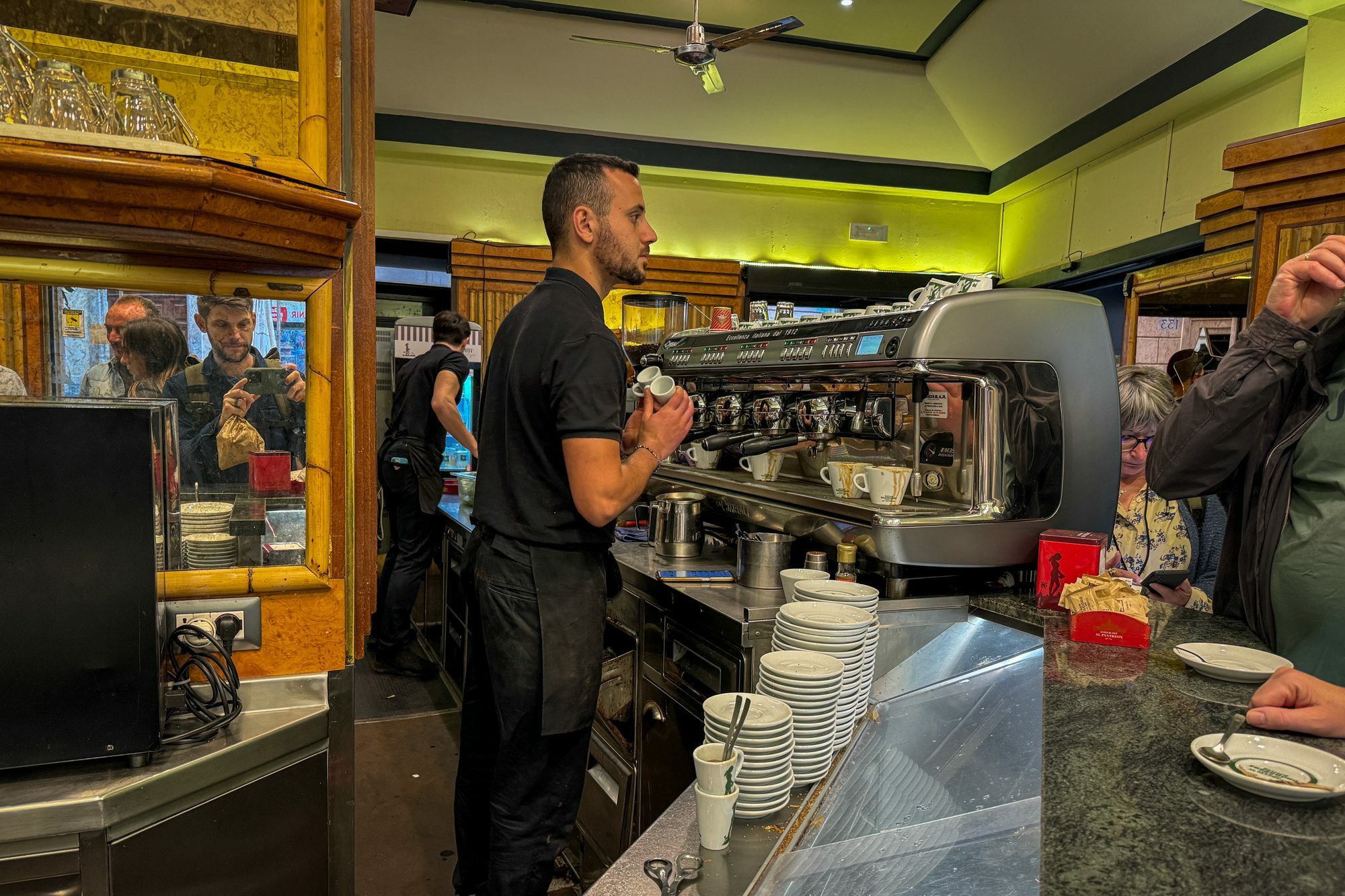
Tazza d’Oro is a classic, this Italian roaster has a bar on a piazza next to the Pantheon that is almost always packed between the hours of 10am and 7pm.
I went here twice over a couple of hours on my latest trip (I’ve probably been here five times across all of my trips to Rome) – once on my own, and once on a walking tour with a local who picked it when I said I wanted to experience espresso at the bar at his favorite place nearby.
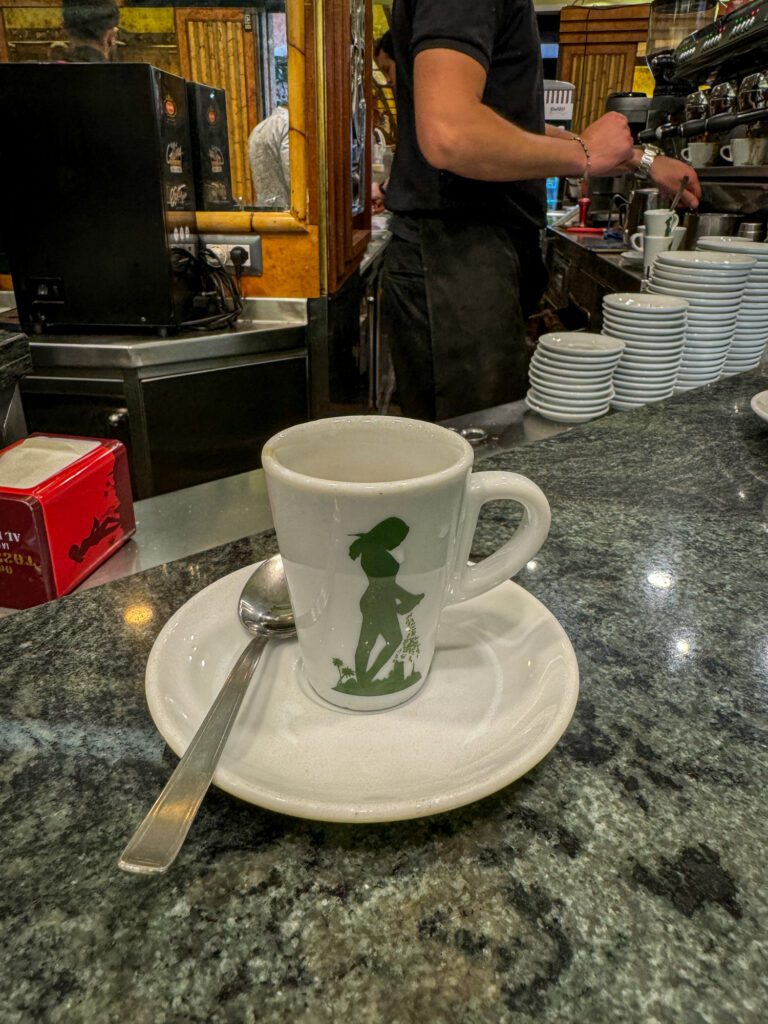
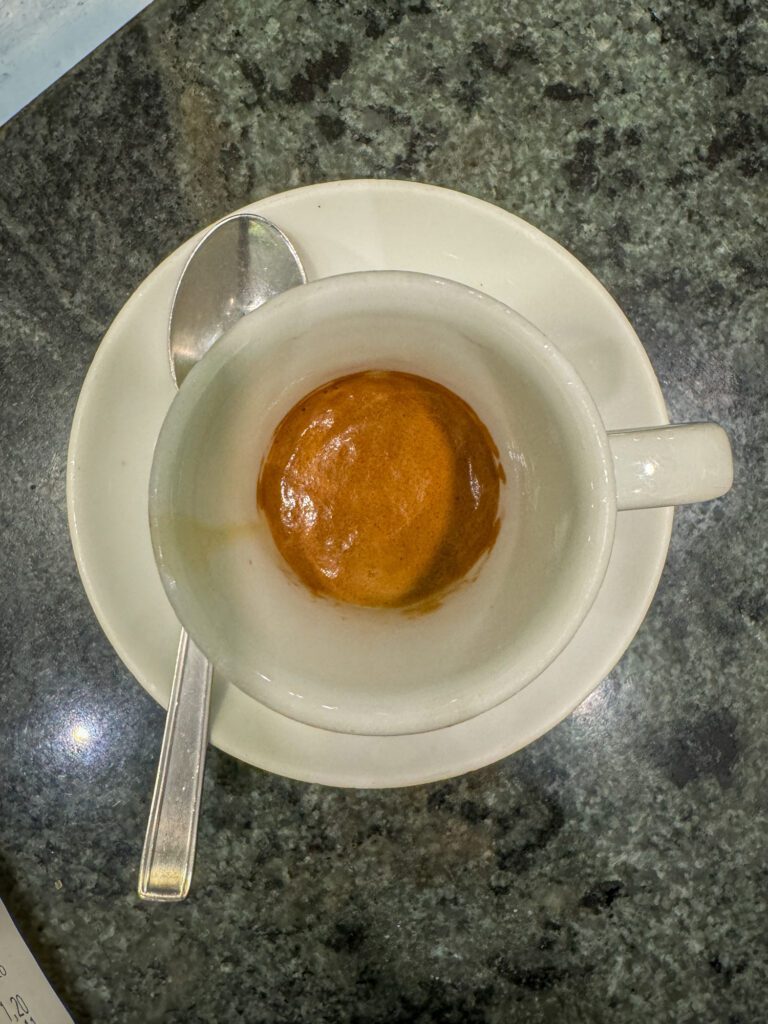
You walk in, pay the cashier, take your receipt, and shoulder your way up to the counter to tell the barista what you want (pro-tip: you can order a ristretto – a lower ratio of coffee to water, more concentrated – or lungo – more water, less concentrated – which you tell the barista at the bar).
Caffe Sant’Eustachio
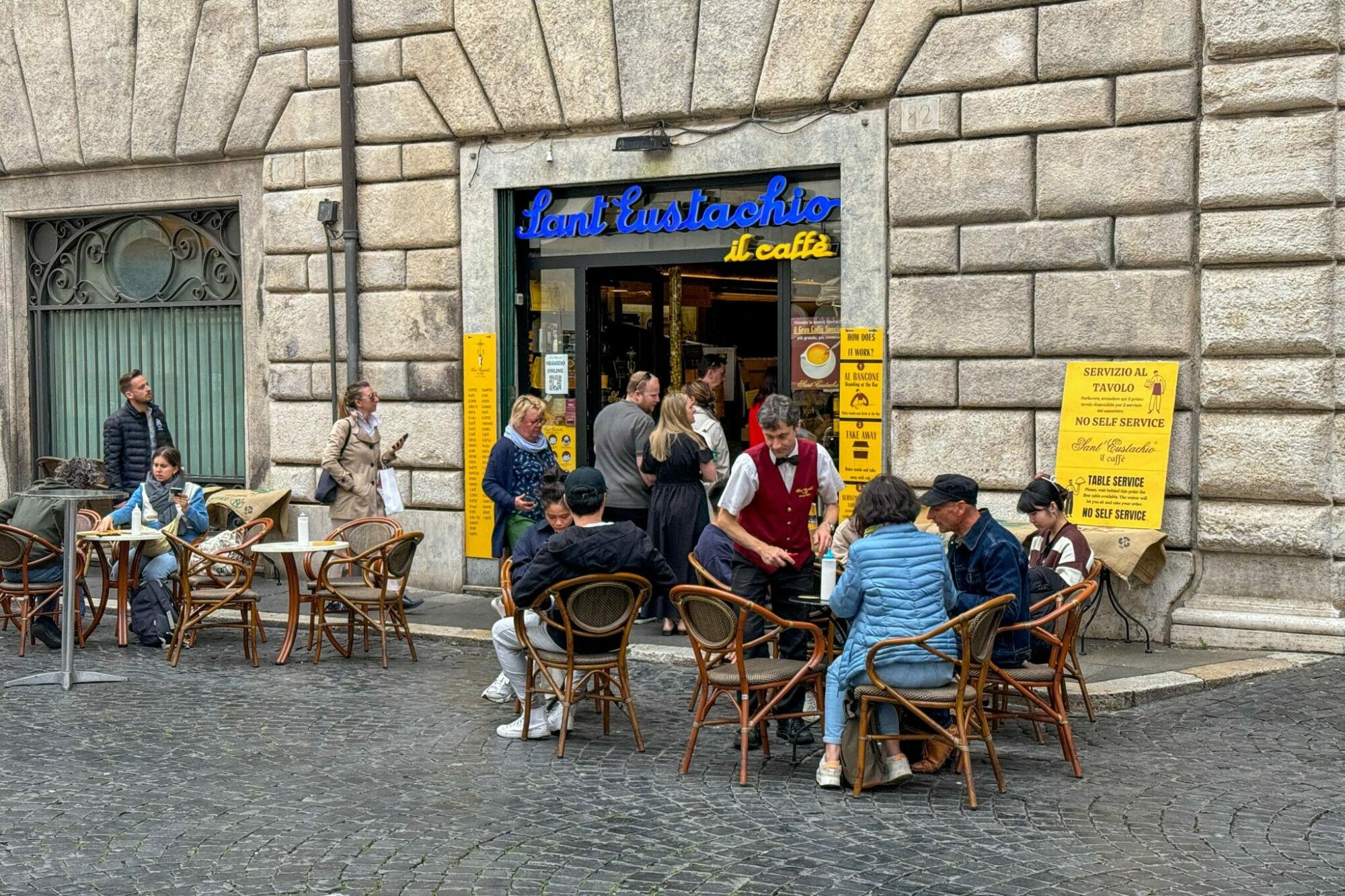
Sant’Eustachio is another spot that is just off the piazza where you’ll find the Pantheon. Walk past the tables outside (which are ridiculously expensive to sit at in terms of the price you’ll pay for the coffee) and head directly inside to order your coffee.
The thing I like about Sant’Eustachio is that they serve their flagship “Gran Caffe” in an interesting way (it’s almost frothy, but I don’t think I’ve seen the barista use a frother of any kind), though it’s a closely guarded secret in terms of what, exactly they do.
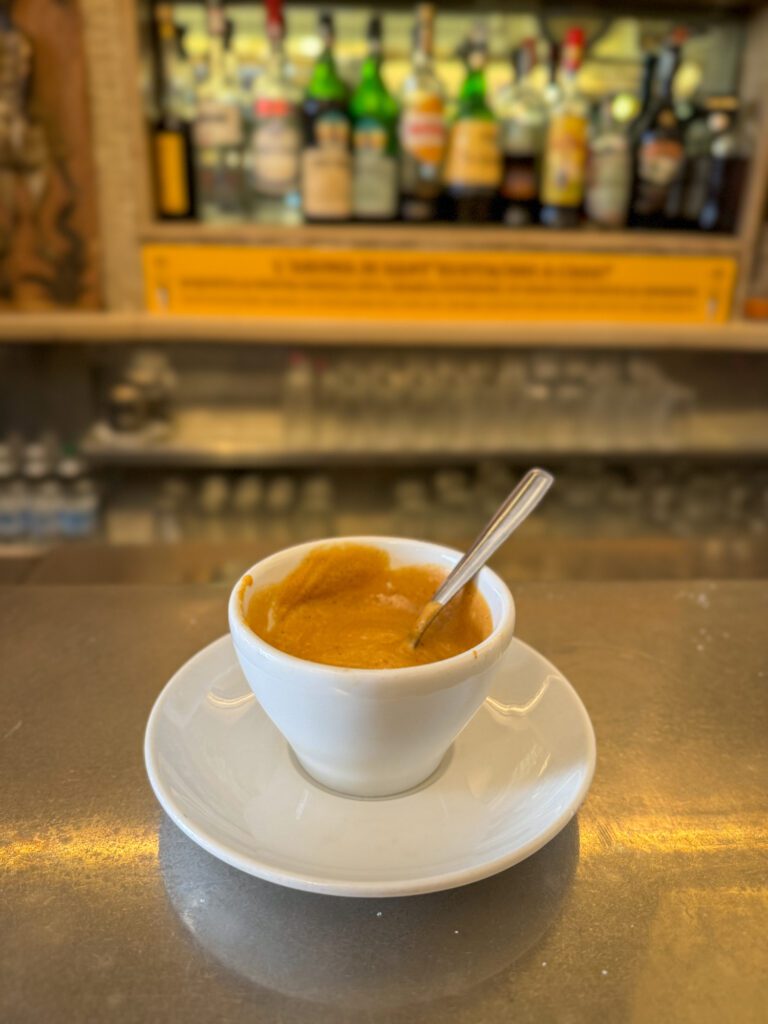
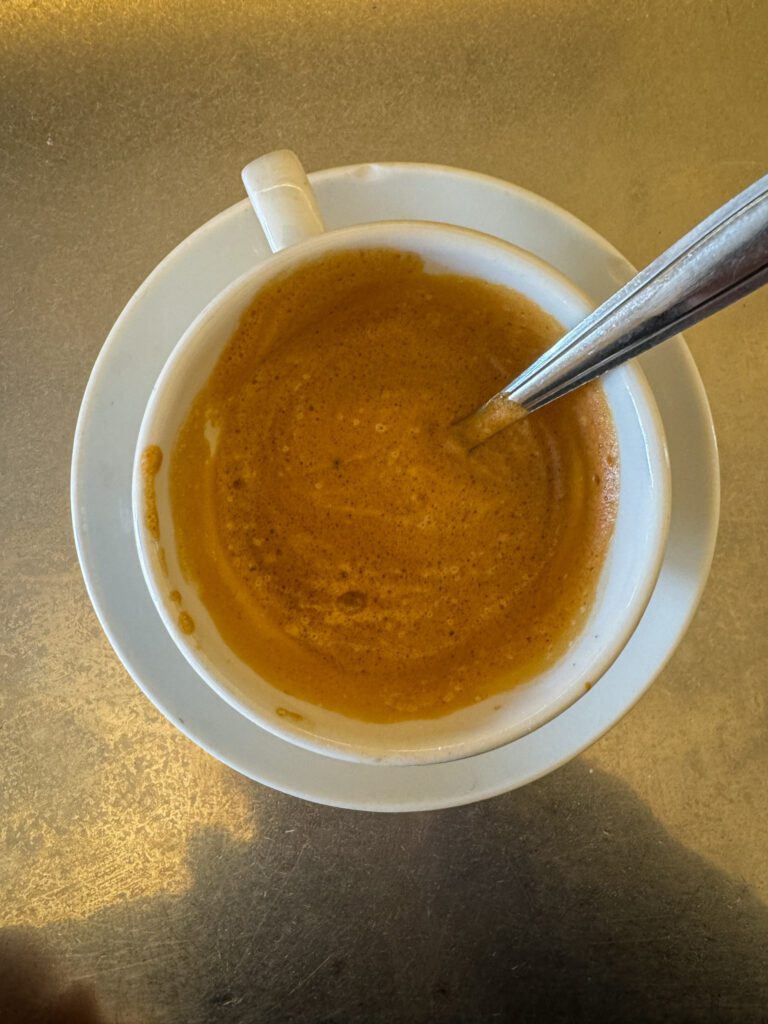
One thing I do know is that they’ve been serving the Gran Caffe for almost a century with sugar, and when you tell the barista what you want, they’ll ask you “con zucchero?” (with sugar).
Most coffee purists will automatically say no, but after trying it both ways, I actually think the sugar makes it a more pleasant drink.
And that’s how they designed it, after all, as the signs all over the bar tell you in Italian and English.
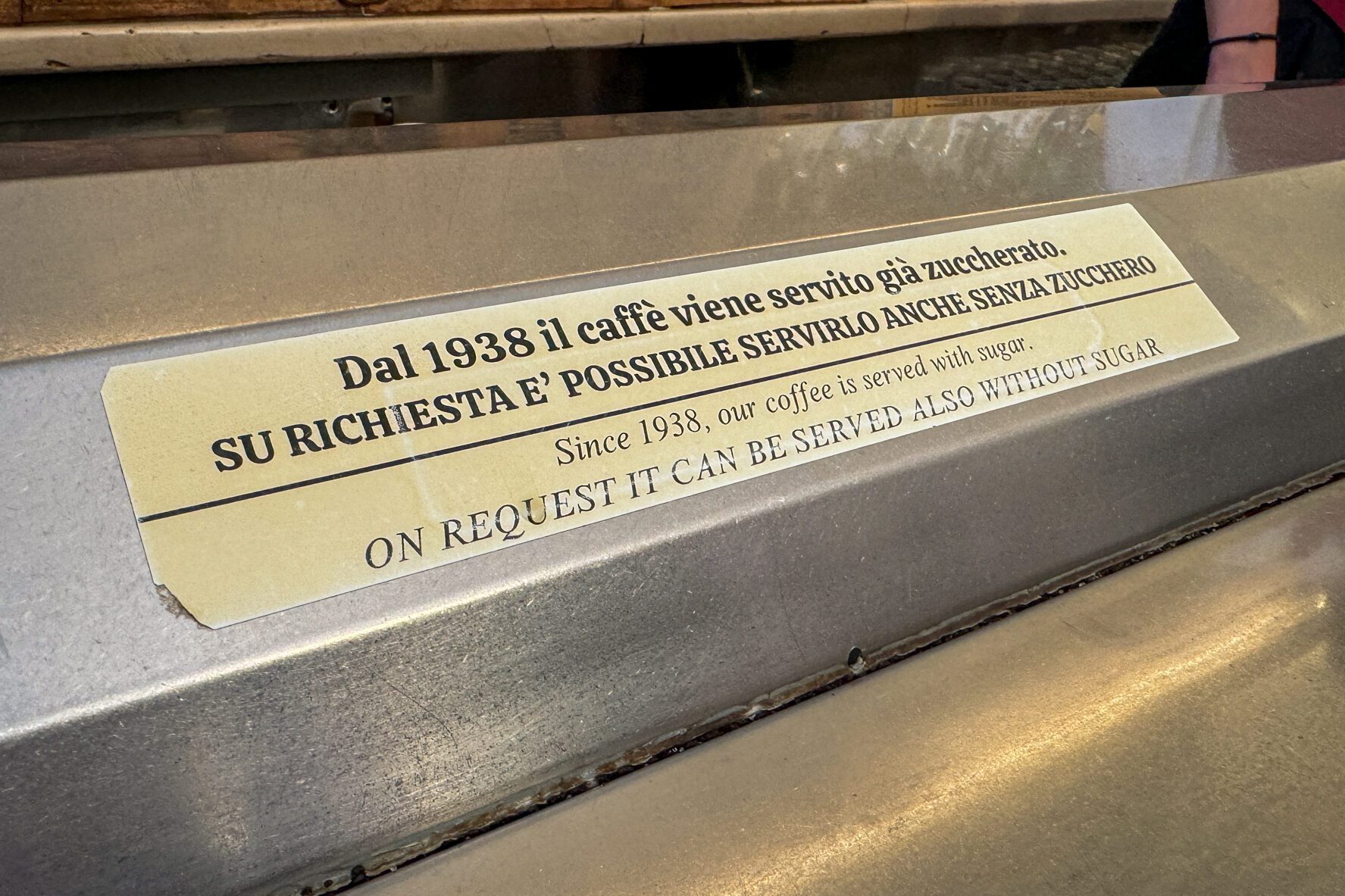
Where to Find the Best Specialty Coffee in Rome
Now, let’s get into the places where you’ll go beyond the “single shot at the bar” and find specialty coffee.
In terms of the process for putting together this guide, I do tons of research on coffee shops before my trips involving big Excel spreadsheets and priority rankings so that I make sure to hit the places I’m most excited about.
However, it’s also worth noting that most of my best finds come from asking baristas in my favorite shops for their recommendations, which almost always helps me uncover a new place or two to add to my list.
I’d highly recommend you do that yourself if you’re interested in finding the cool new spots serving up great coffee in Rome.
A quick note on my coffee preferences, because it definitely matters: I’m all about the lightly roasted, fruity, floral, and bright coffees. Both as filter, and also as espresso. I’m an avid home brewer, making several cups of coffee a day either as pour over or as espresso. Some might call my tastes “fancy” or “snobby” (that’s Alysha’s word). But over the last few years, I’ve figured out what I like, and that’s what I’m always looking for when I’m out trying new coffee shops.
LOVE Specialty Coffee and Croissants (Multi Roaster)
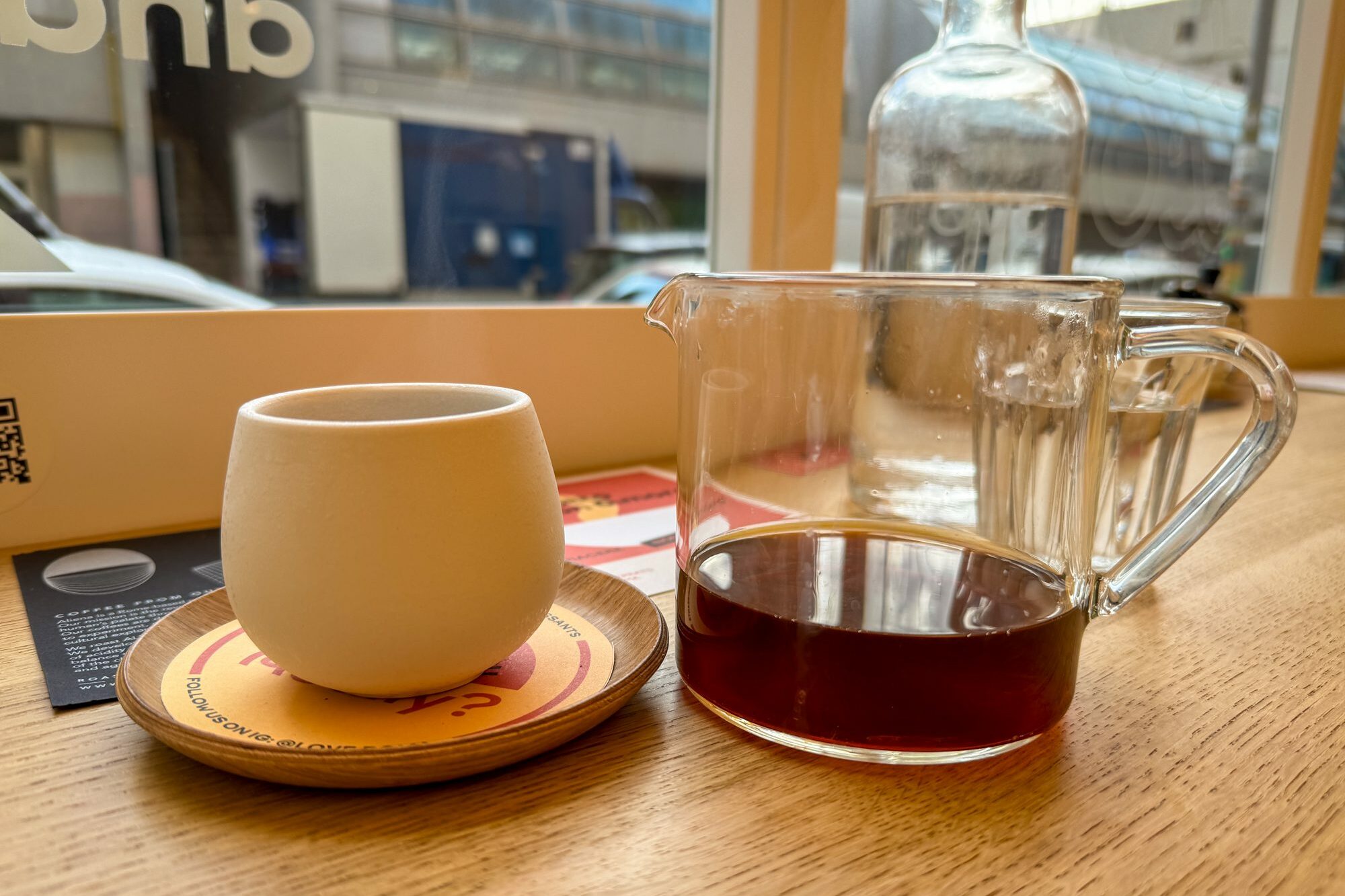
If you’re looking for the best selection of international roasters in Rome, this is probably it (though Fax Factory is up there too).
If we’re being completely honest, I was at least a little bit skeptical of LOVE before I actually experienced their coffee for myself.
Mostly, that’s because their Instagram is exclusively beautiful shots of their pastries, which look delicious, but are definitely not gluten free, so they’re not particularly interesting to me.
In fact, when I ordered my coffee on my first visit, the person taking my order looked dumbfounded when I said just the coffee and skipped their pastries.
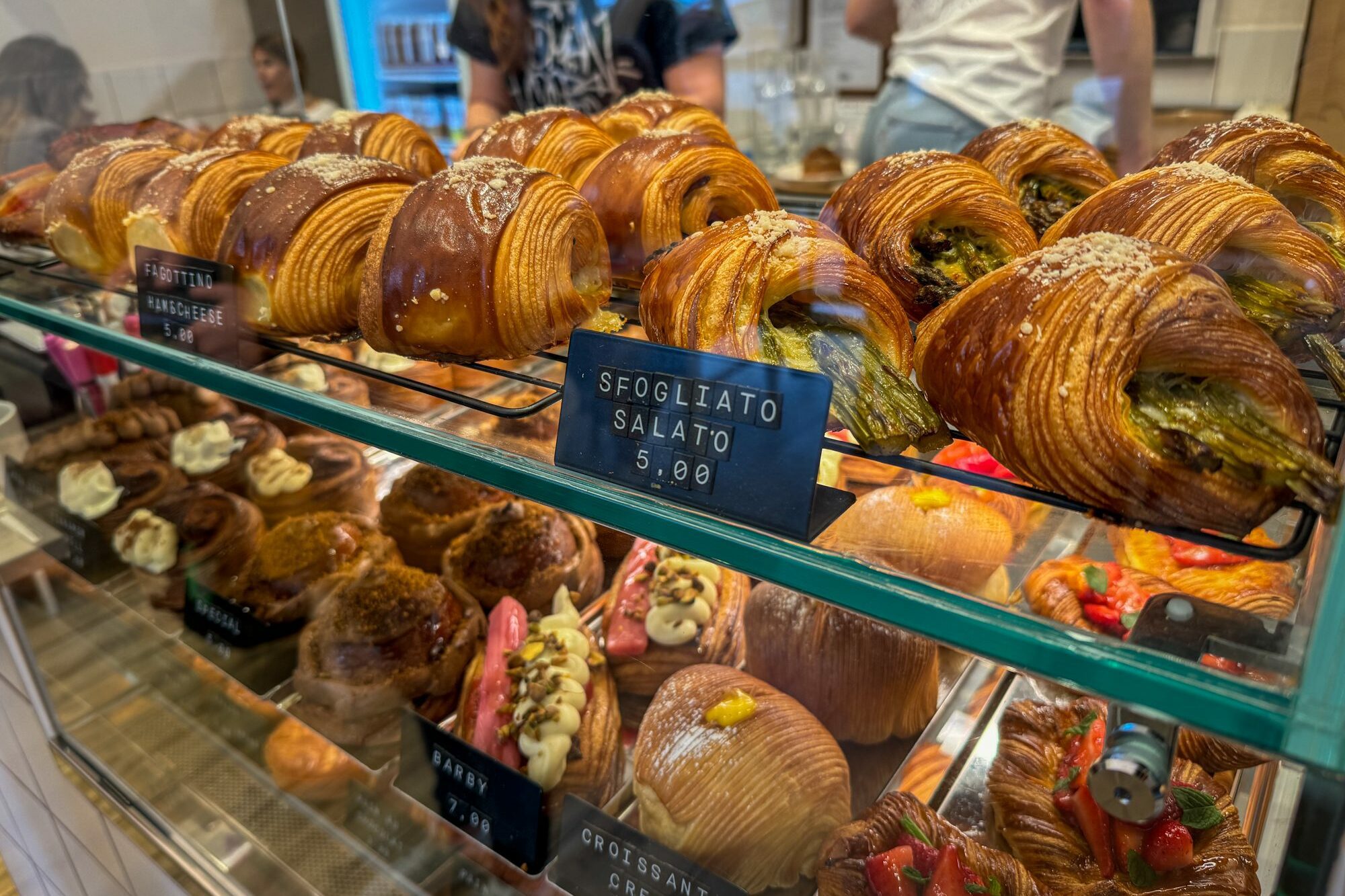
LOVE is in Prati, a few blocks from Pergamino (which would make a nice one two coffee punch) and the Vatican. It’s a busy spot, and it quickly became apparent why when I stepped inside.
In a city (country?) where many people start their day with a light breakfast of coffee and cornetti, this is perhaps the most elevated take on that idea, with great specialty coffee offerings from espresso and milk drinks to hand brewed filter coffees (with a selection of beans that ranges from basic to rare) and handmade fresh pastries that look incredible.
But this guide is, after all, a guide about coffee and my experiences exploring Rome’s coffee scene, so let’s talk about the coffee.
They are very much a multi roaster, working with Aliena, a local roaster who is affiliated with Faro (which is a good option that you’ll find below), and other roasters around Europe (they also had the Barn and Manhattan when I was there).
On my first visit, I gravitated immediately towards the Ecuadorian Sidra, which has quickly become one of my favorite varietals (after pink bourbon, the GOAT).
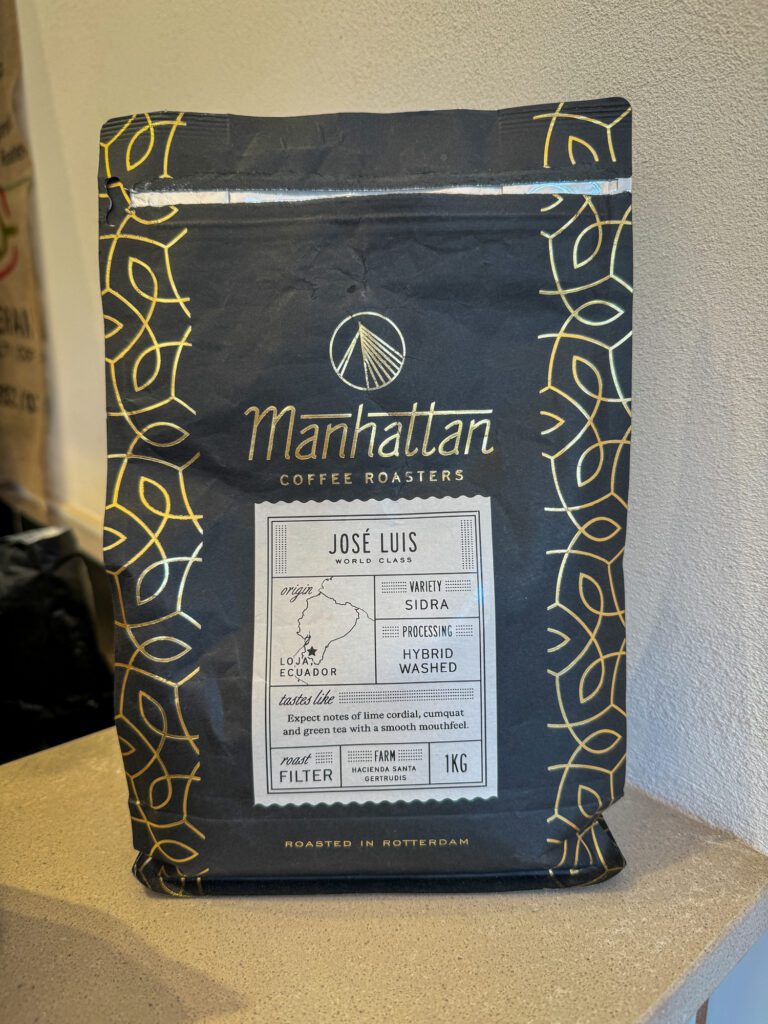
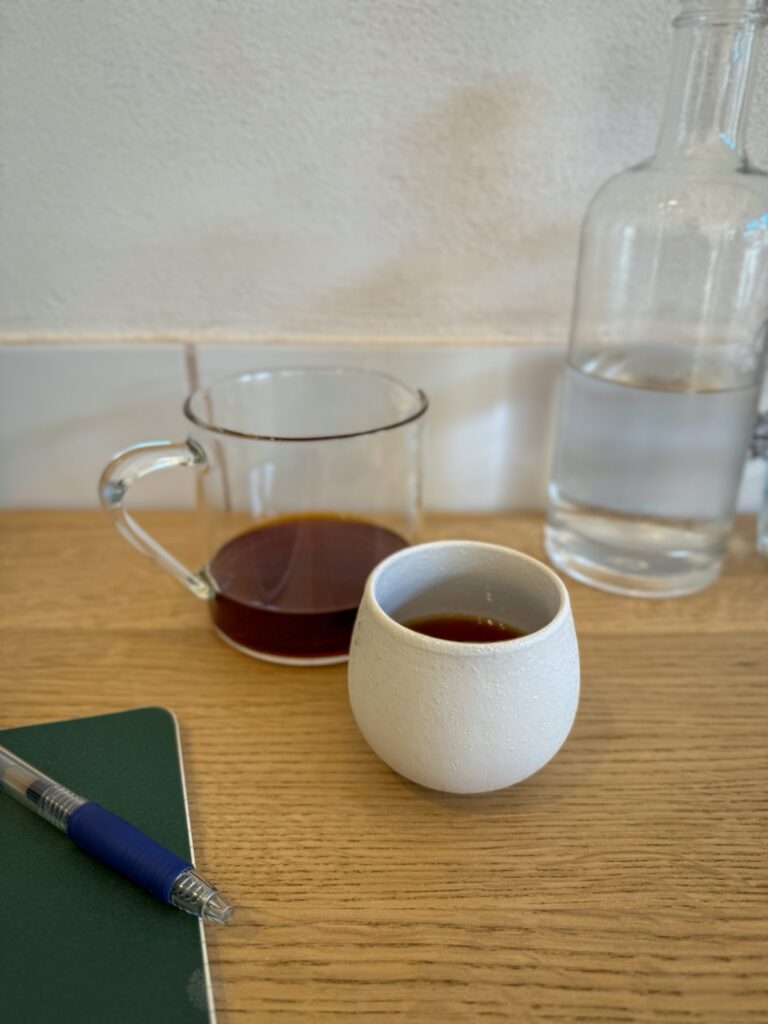
It was roasted by Manhattan, and the barista patiently chatted with me at the bar while they prepared it as I stumbled through questions about the process in semi-coherent Italian.
The end product was a bright and juicy cup with a lemon curd sweetness that was easily my favorite cup of coffee in Rome.
I enjoyed my time here so much on that first trip that I made a second special trip to visit before I hopped on the train, and they remembered me (presumably because I asked all sorts of questions) from my first visit.
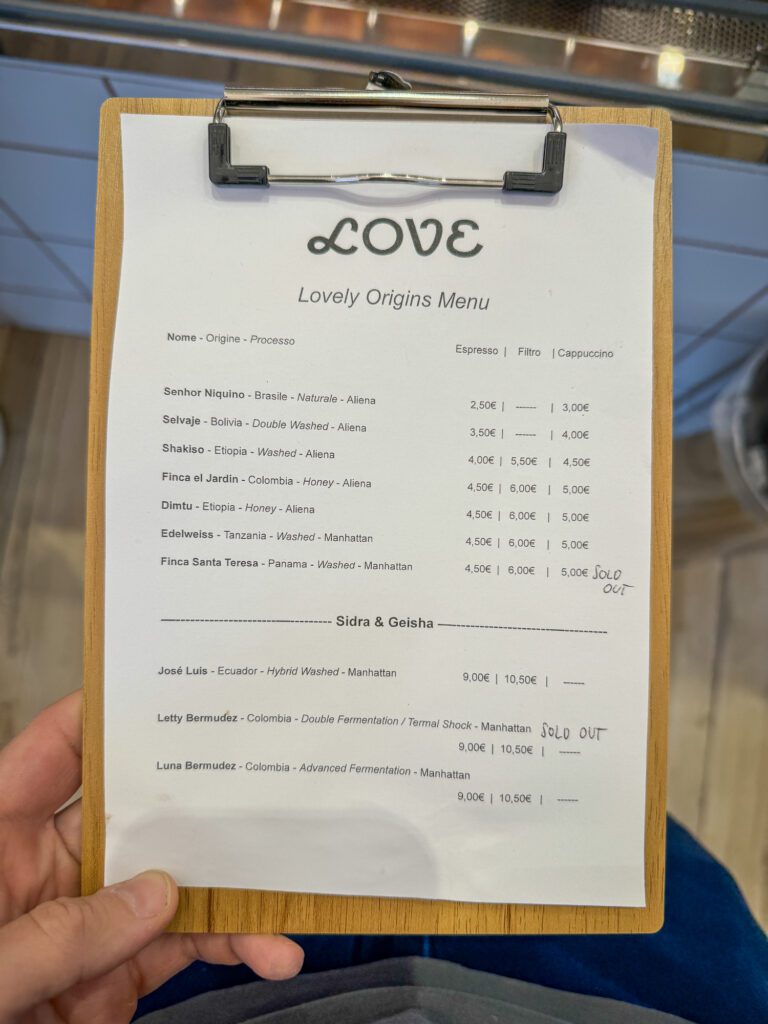
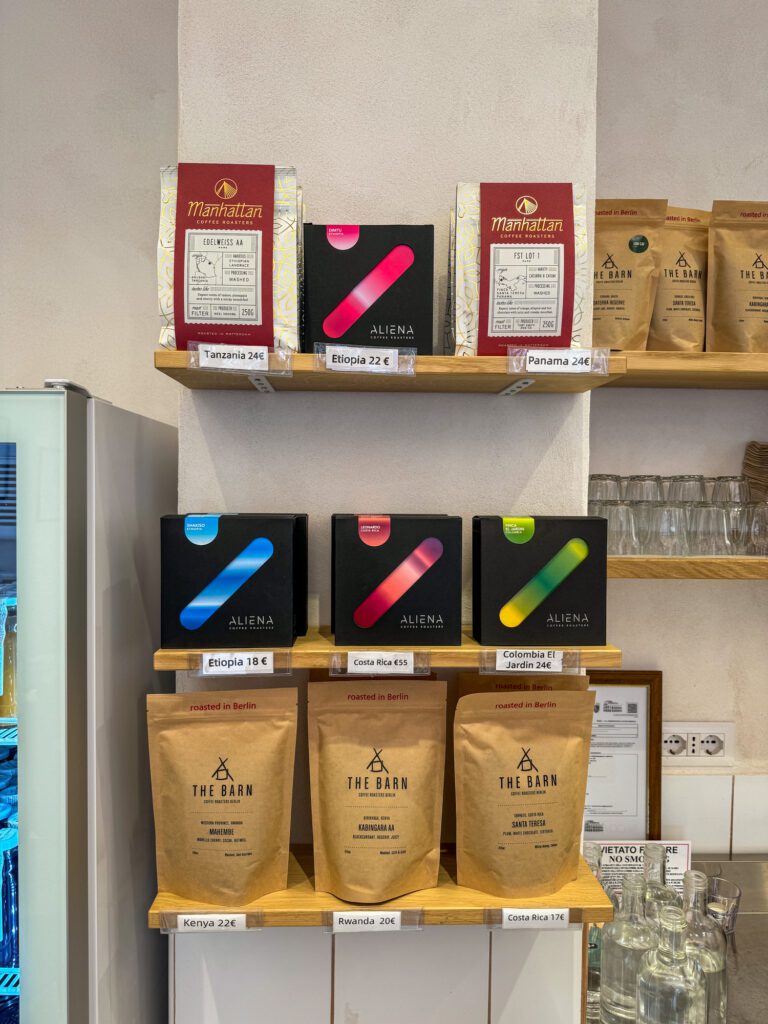
On that second trip, I was interested in a specific coffee that the barista had recommended to me on that first trip – a washed Tanzanian coffee also roasted by Manhattan – that was also very good, but not nearly as memorable as that first coffee they brewed for me.
Fax Factory (Multi Roaster)
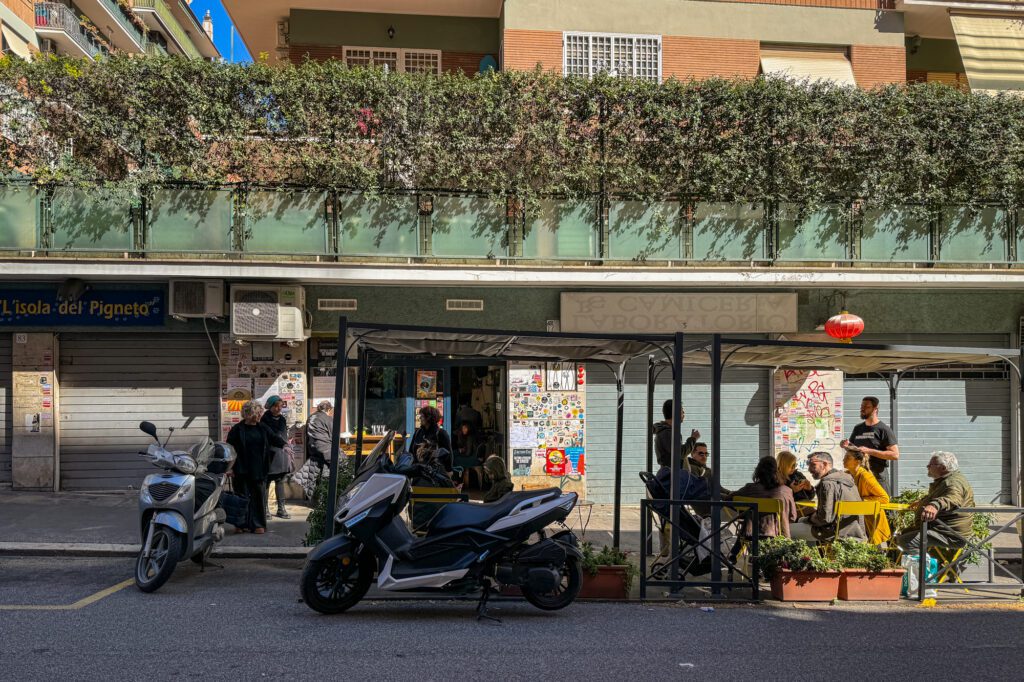
Fax Factory is the place on this list that is furthest off the beaten path, but their selection of beans from European roasters – many of whom are more niche that I’ve never seen elsewhere – is worth the journey if you’re looking for one of the more interesting coffee experiences in Rome.
They’re in a cozy space over in Pigneto, which is a short tram ride to the southeast of Termini.
I was the only person who wasn’t speaking Italian, and I found that a nice change of pace from being in the historic center and hearing alllllll the different languages as I was meandering around.
The thing that really sets Fax Factory apart, at least in my opinion, is the selection of roasters that goes well beyond the usual roasters you see at multi roaster shops in Europe (the Manhattans of the world).
Here, they have roasters like Oven Heaven in Bordeaux, France, Peacocks from Brianza (a small city in Italy), and even a Lithuanian roaster called Taste Map.
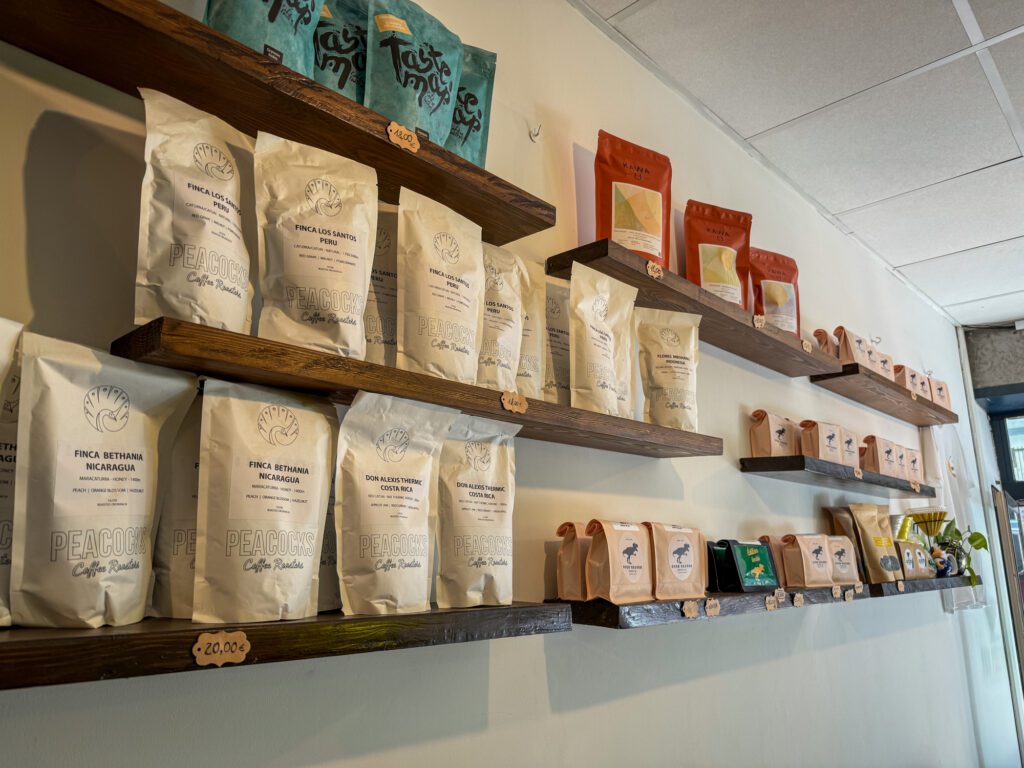
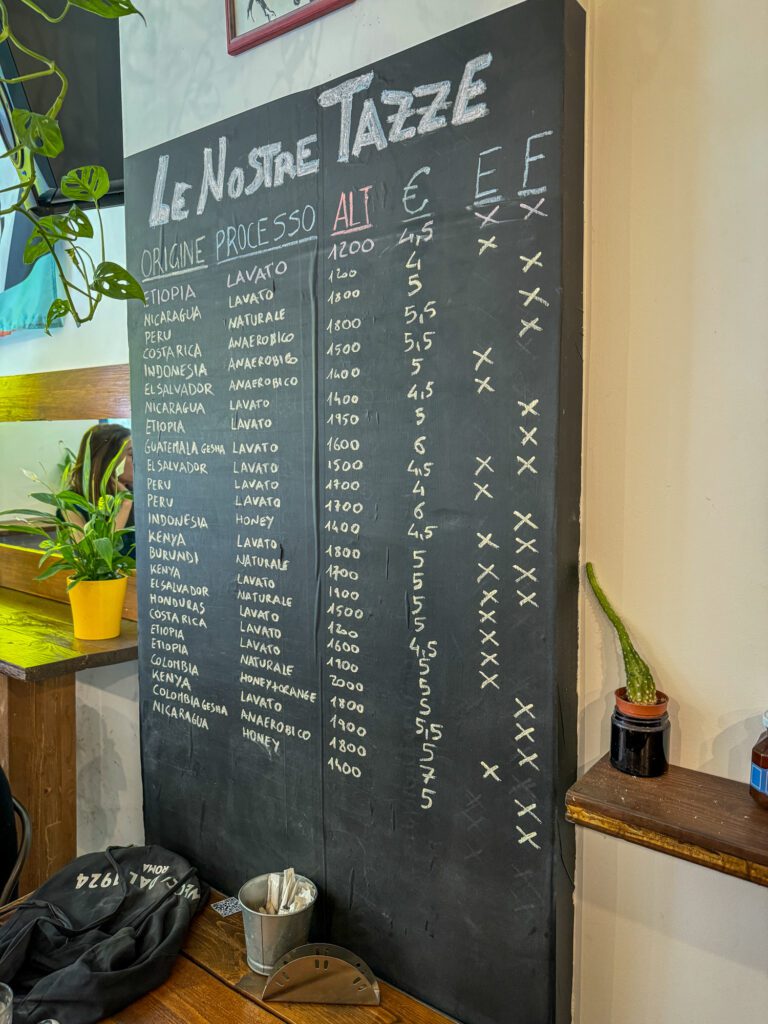
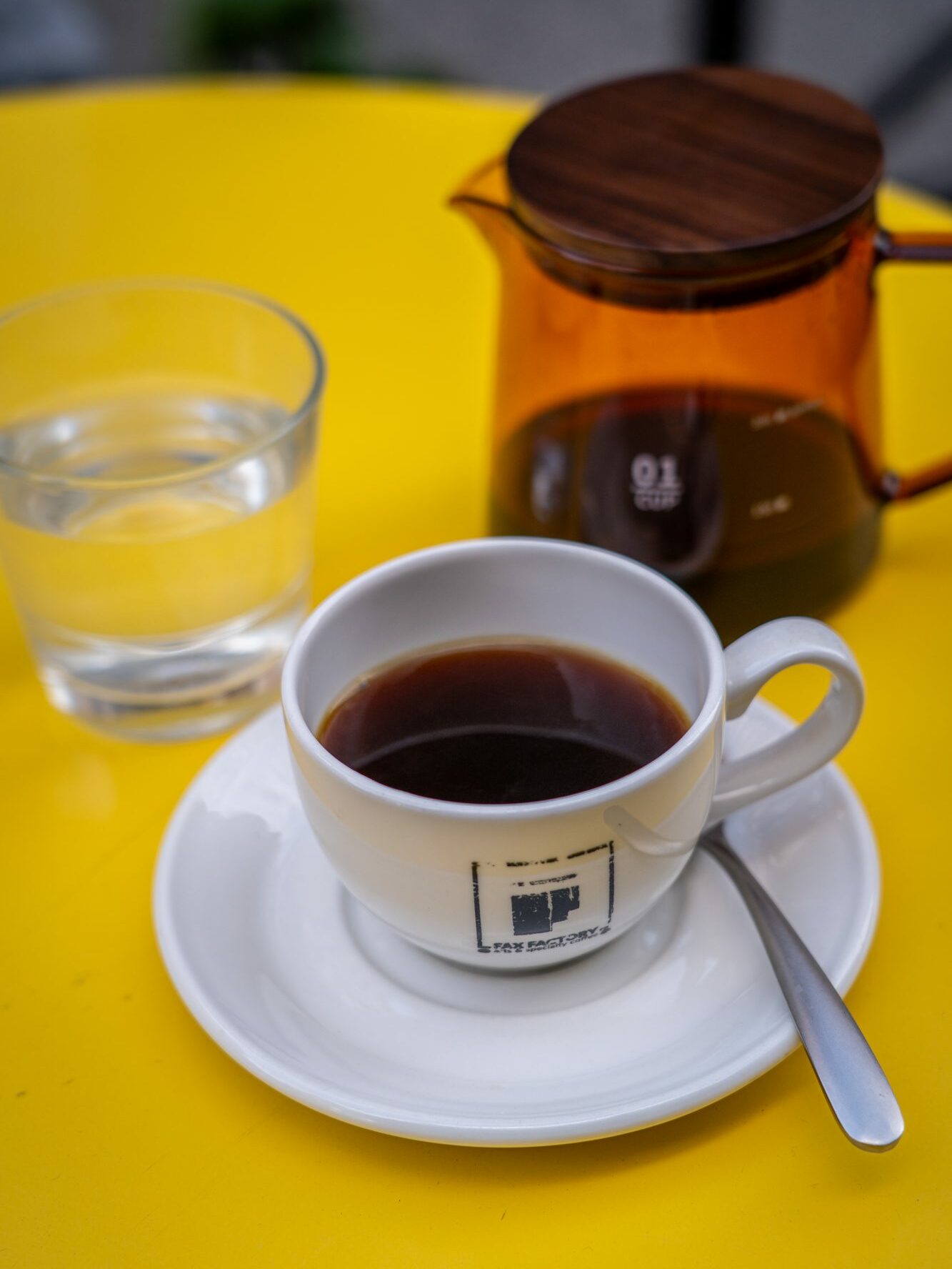
For example, I had an Ethiopian coffee roasted by Oven Heaven coffee in Bordeaux, France, which is a micro roaster I had never personally heard of.
I enjoyed it so much that I promptly ordered an espresso of a coffee that the barista had recommended, and walked away EXTREMELY caffeinated.
If you’re looking for a unique selection of roasters and are willing to make the journey, I highly recommend it! Bonus points for not a single word of English being spoken while I was there on this latest trip.
Faro – Caffè Specialty (Coffee Roaster, ish)
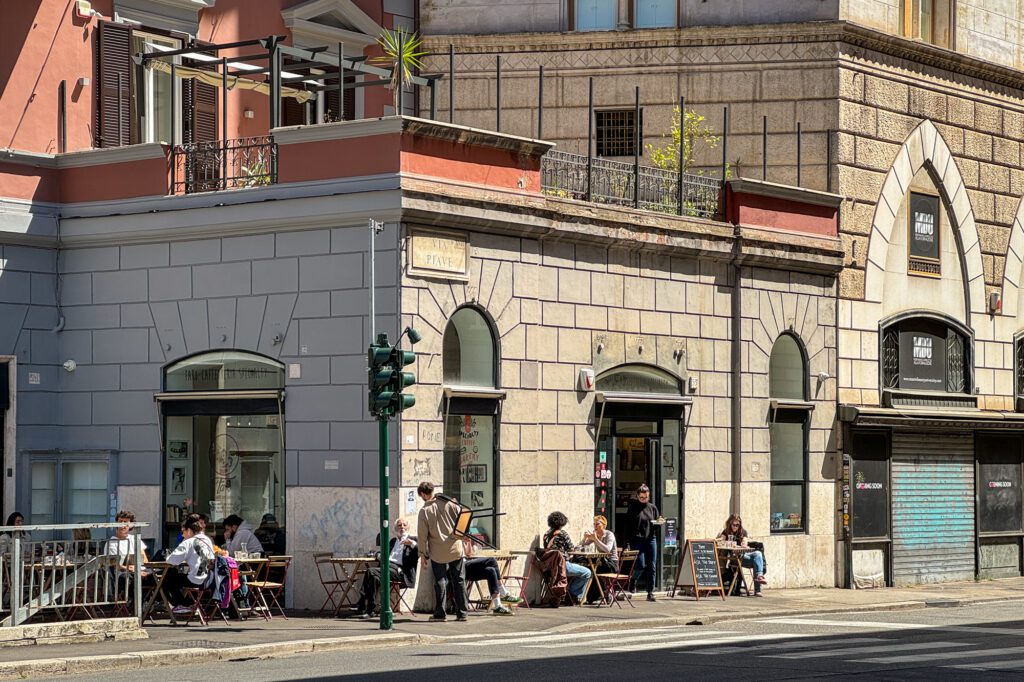
On my last trip, I stopped by Faro on a sunny afternoon in Rome to grab a cup of coffee before a tour of the Borghese Gallery and found that it had changed quite a bit since my last visit a few years prior.
At this point, I’ve been to Faro several times over the course of my past two or three trips to Rome, and it’s a staple of the city’s coffee scene.
You’ll find them about a half mile (15-20 minutes on foot) due north of Termini, on the southeastern border of Villa Borghese. It’s not the most convenient place to stop by on this list, but it’s also not the least convenient (that award goes to Fax Factory, though I think it’s worth the journey if you’re into specialty coffee).
There are two things that stand out to me here, and this has been consistent across all of my visits: the quality of the coffee (and care in preparing it), and the relative coldness of the staff.
Taking the second one first, I have found that at most places in Rome, I have been greeted with graciousness and warmth when I do my best to complete the initial interaction – ordering and paying – in Italian before eventually running out of runway and asking if we can switch to English.
I have never been given that grace or warmth at Faro.
And, to some extent, I get it – it’s a customer service business that’s always busy, and I’m just some random tourist who doesn’t speak Italian and that they’ll never see again.
But that doesn’t change the fact that it’s just a worse experience when you aren’t able to engage with people (and it’s not from lack of trying).
Anyway, your mileage may vary (especially if you speak / look Italian), but that was one of the first things I jotted down about the experience here on my last trip, which says something.
Still, the coffee is good, and you should definitely still visit for that reason!
As I walked in and up to the bar on my last visit here – keep in mind, it’s ~2pm on a weekday afternoon – the barista asked me if I had a reservation.
Which I didn’t know was a thing, but it turns out that they’re trying to put more emphasis on their food program, and the seats inside were all reserved for people who were eating lunch (there were exactly two people doing so). I have Celiac Disease and need to eat gluten free, so eating here wasn’t really an option.
Which was totally fine – I wanted to sit outside anyway – but it’s something to keep in mind if you’re planning on visiting. You can either stand at the bar, or sit outside if there’s a table available.
The other big thing that has changed is that they have gone from a multi roaster model (they used to work with famous European roasters like the Barn from Berlin) to roasting their own coffee under the Aliena brand.
Which is cool! They had coffees from famous producers and farms, and a variety of origins and processing methods from traditional washed coffees to funky anaerobic coffees.
I had a honey-process Ethiopian coffee from Sidama called “Dimtu”, and it was lovely. Everything you want in an Ethiopian coffee – delicate, orange fruit sweetness, and slightly floral.
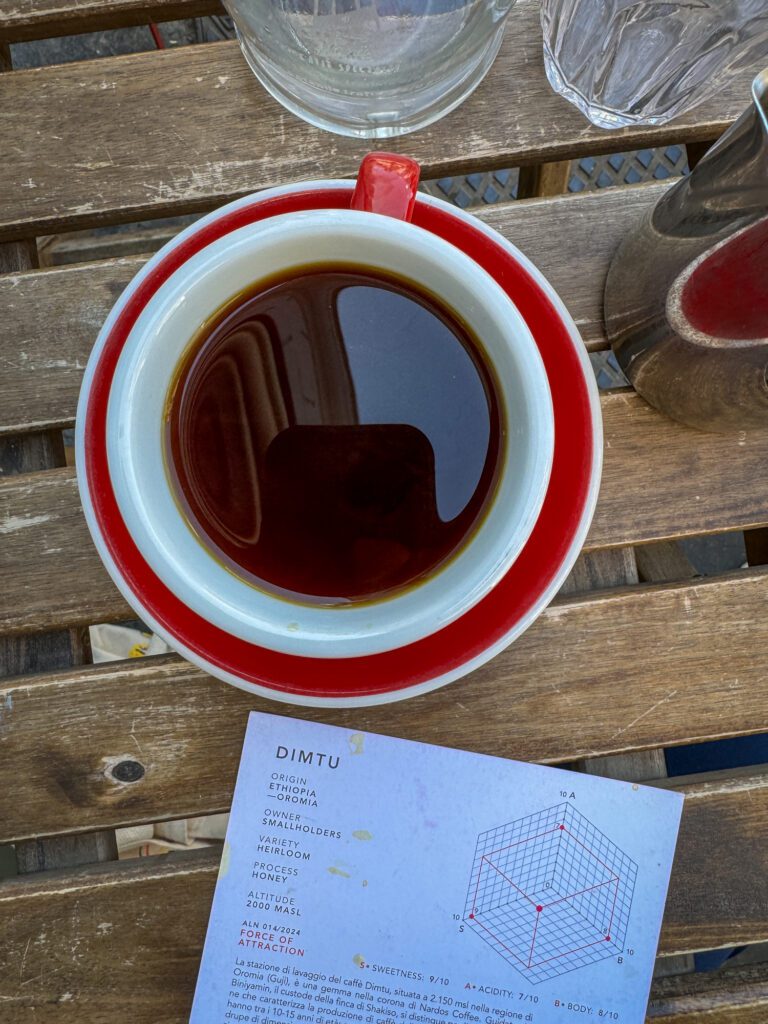
Not a hint of bitterness, which is a testament to both the brewer and the roaster (and is something you don’t always get in Rome).
They also had some more highly processed coffees on their menu, if that’s what you’re looking for.
Barnum (Multi Roaster)
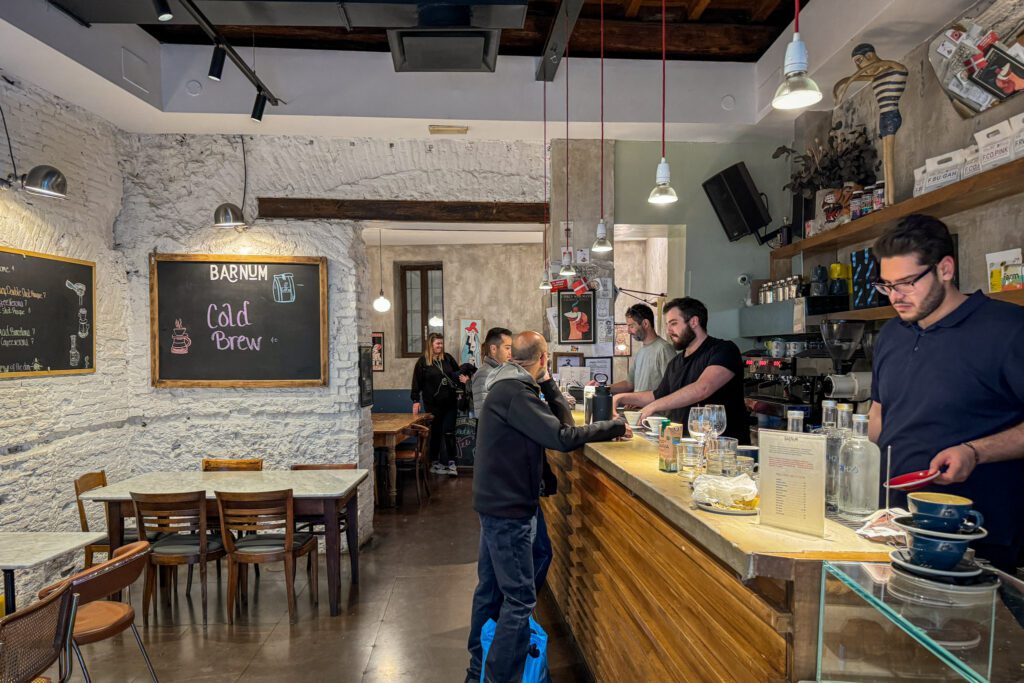
On every trip, there is almost always a coffee shop that comes as a result of asking other baristas where I should go. This is one of those situations.
I had been to Barnum a few years ago, and it was…fine. The emphasis was very much on the food, and the coffee seemed like more of an afterthought.
However, over the past few years, they have absolutely made an incredible step forward in their coffee program, and are now bringing in all sorts of exciting roasters (mostly from around Europe) and brewing them in modern styles (pour over and espresso, but longer shots than you find elsewhere in Rome).
Seriously, head over to their Instagram and check out the rotation of roasters they have going on. It’s impressive. Also notice that nearly every post is about coffee, which tells you what they’re focused on.
I sidled up to the bar on a weekday afternoon, already plenty caffeinated and about to make my way north to the Stadio Olimpico to catch a Roma match.
I showed up at the right time because the barista was explaining their coffee menu to someone in English, and I got to hear it.
Basically, they are looking for interesting coffees from around the world (though as I said, mostly Europe) with a variety of flavor profiles, and they are constantly changing the coffee they are brewing.
It’s also worth noting that the barista spent 5-7 minutes with this person helping them choose a bag of beans to take home, walking them through just about every bag on the shelf.
On the wall across from the bar, you’ll find a blackboard with coffees written in chalk.
They have three categories – Aeropress, V60, and espresso – with a couple of coffee options for each. If you’re not sure what you want, the barista is more than happy to walk you through the offerings and help you find a coffee that will fit your preferences.
I had a washed Colombian coffee roasted by Nomad (my favorite coffee shop in Barcelona), and as you can see from the picture, they’re definitely pulling more modern espresso shots (read: more liquid pushed through the coffee) than you’ll usually find in Rome. And it was good!
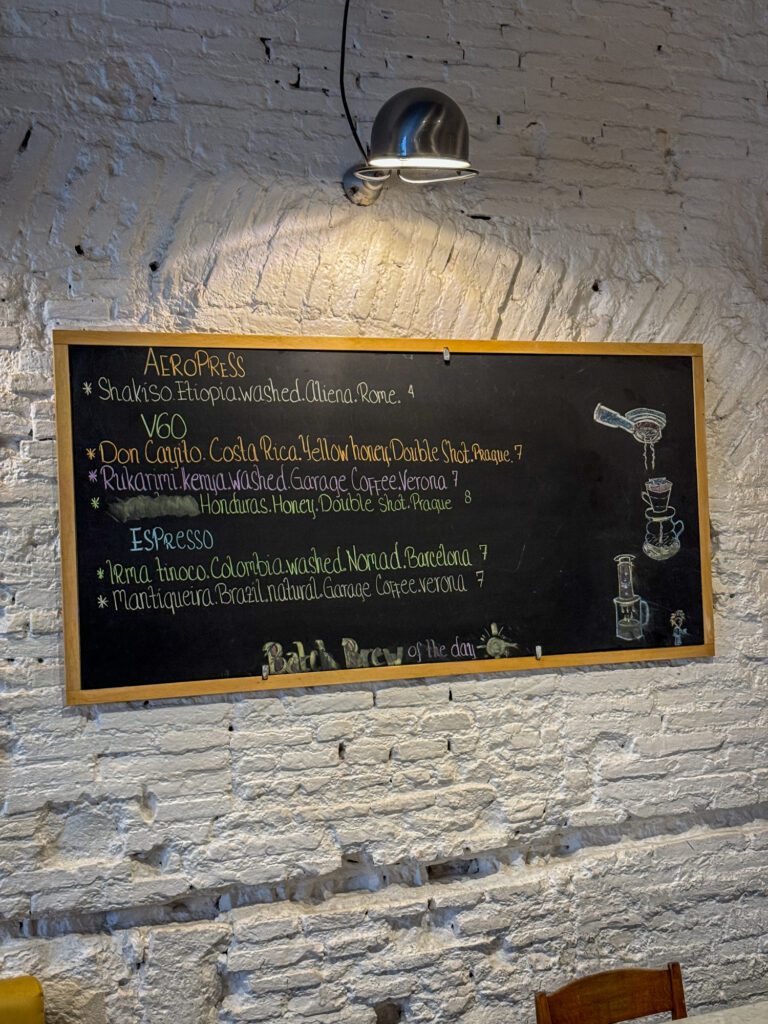
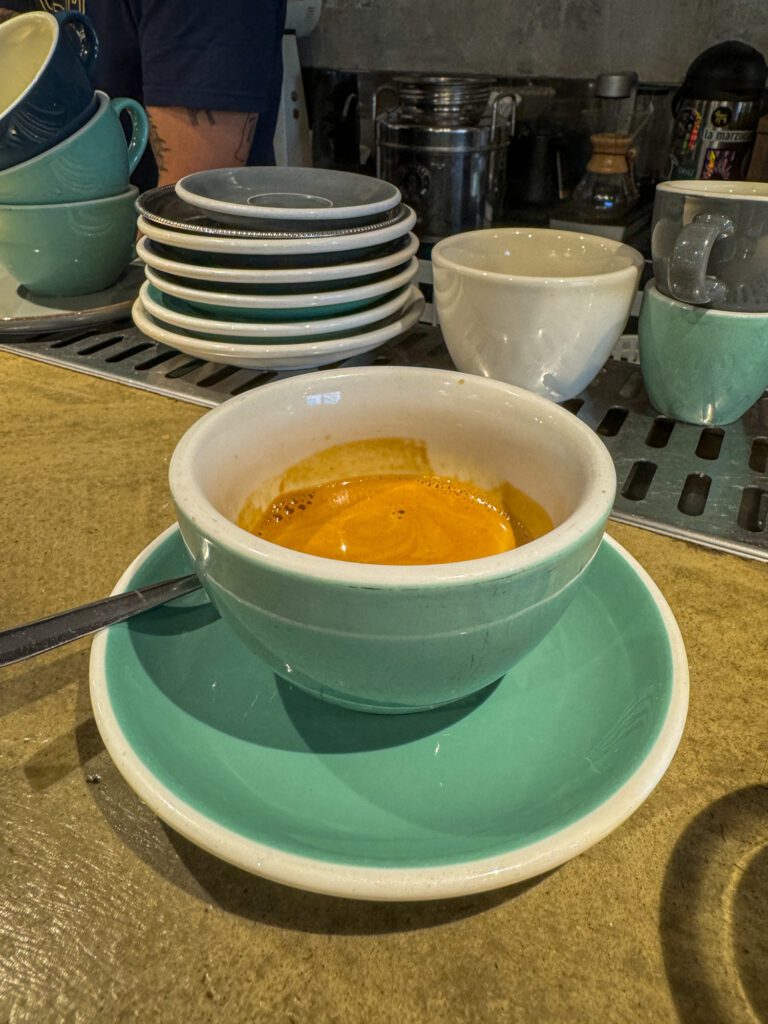
I wish I had made it back a second time during my trip to try a filter coffee, but I opted for LOVE instead.
On my next trip to Rome – likely in the next year or two – this will be one of my first stops for coffee in Rome.
Pergamino Caffè (Multi Roaster)
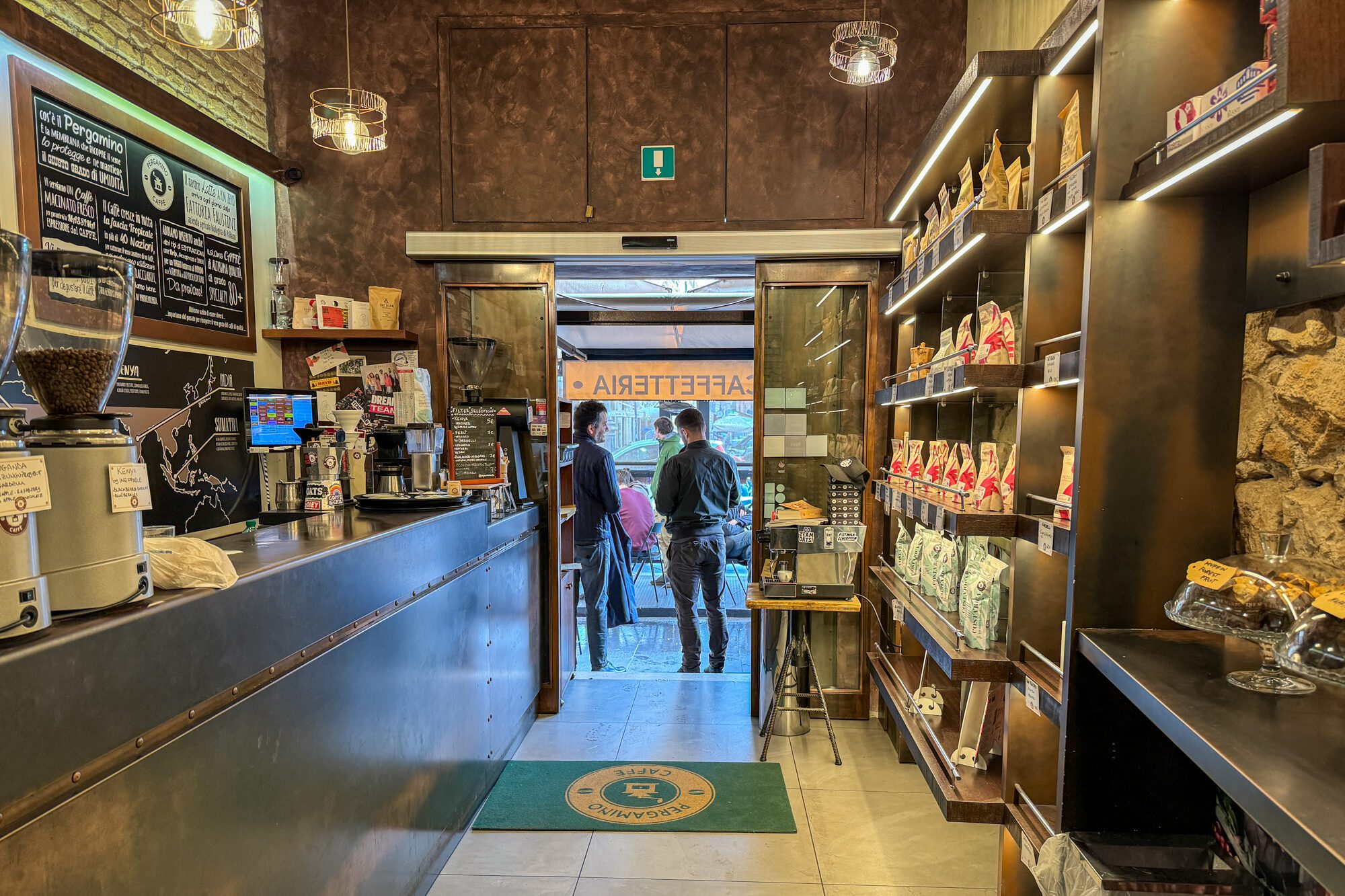
I have now been to Pergamino across three separate trips to Rome, and the one thing I can say is that it has absolutely kept its mission to introduce people to specialty coffee intact across those visits.
As far as I know (and I actually asked a couple of baristas at other places to confirm), Pergamino was the first specialty coffee shop in Rome, at least as we know “specialty coffee” today.
Pergamino is basically around the corner from the entrance to the Vatican Museums, which means they deal with a LOT of tourists every single day.
I was standing at the bar enjoying my espresso and chatting with the baristas on this last trip, and three separate people came in to use the toilet without buying coffee or anything (and I was only there for maybe 15-20 minutes).
Still, despite the number of tourists that come here who are largely ambivalent about the quality of the coffee they’re getting, they are serious about their specialty coffee.
They’re a multi-roaster cafe (which, admittedly, is my favorite kind of coffee shop), and they had beans from a couple of Italian roasters (Gardelli from Forli and Garage from Verona, the two best roasters in Italy, I think) along with rotating selections from other European roasters (DAK from Amsterdam, for example).
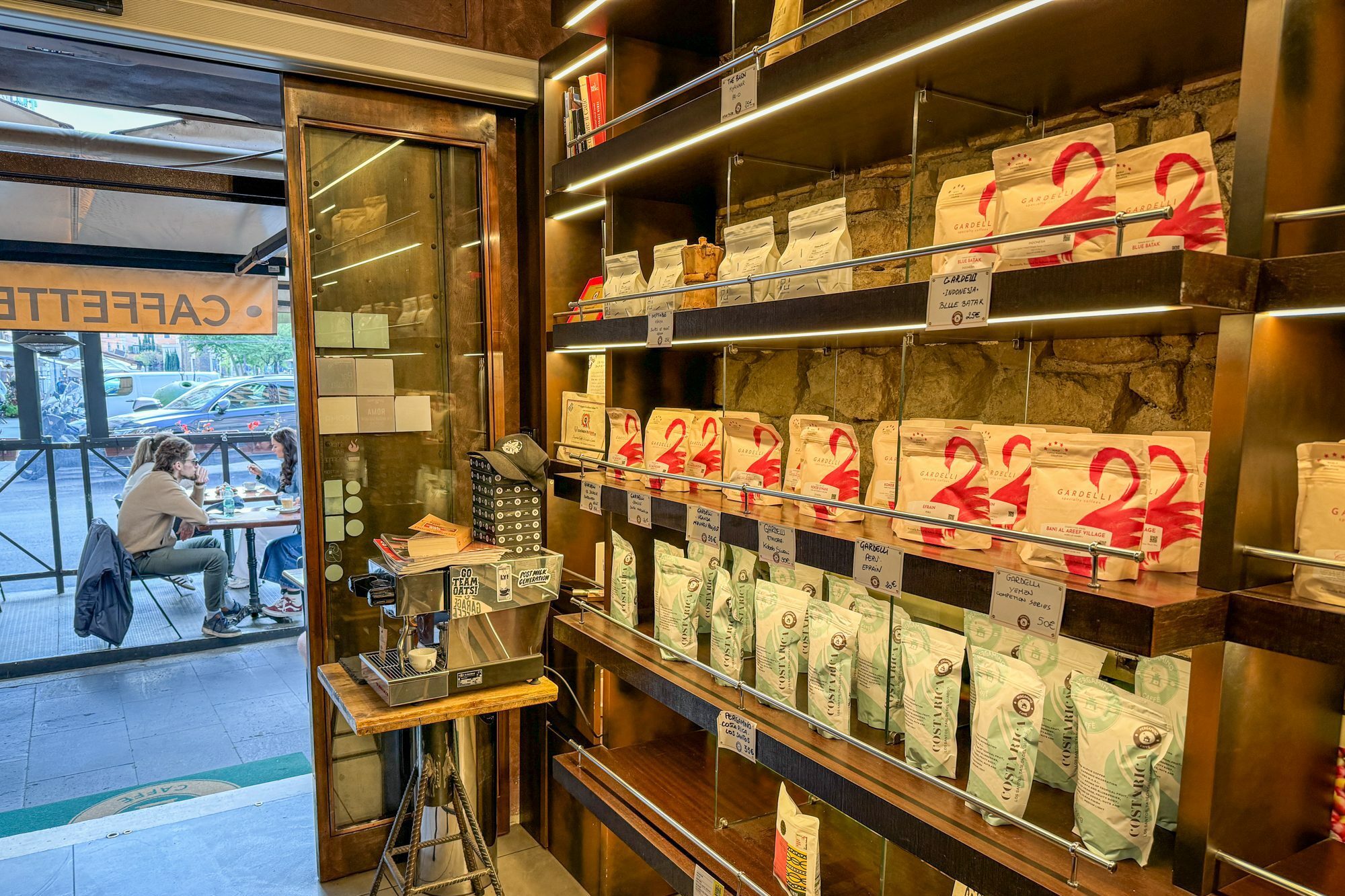
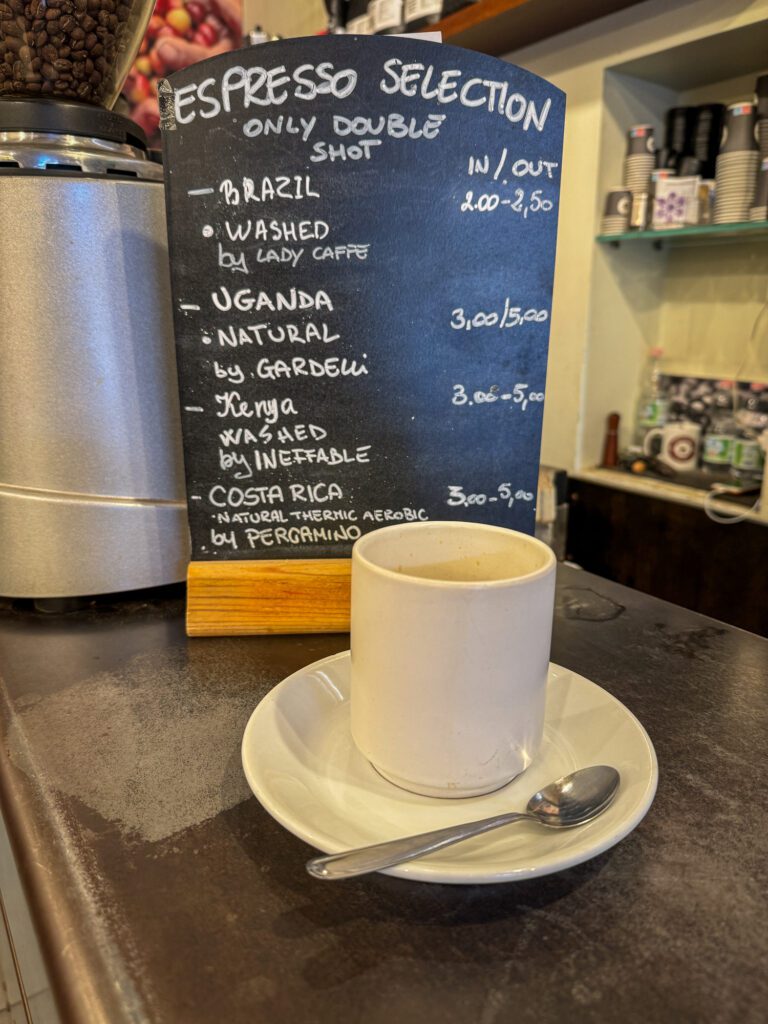
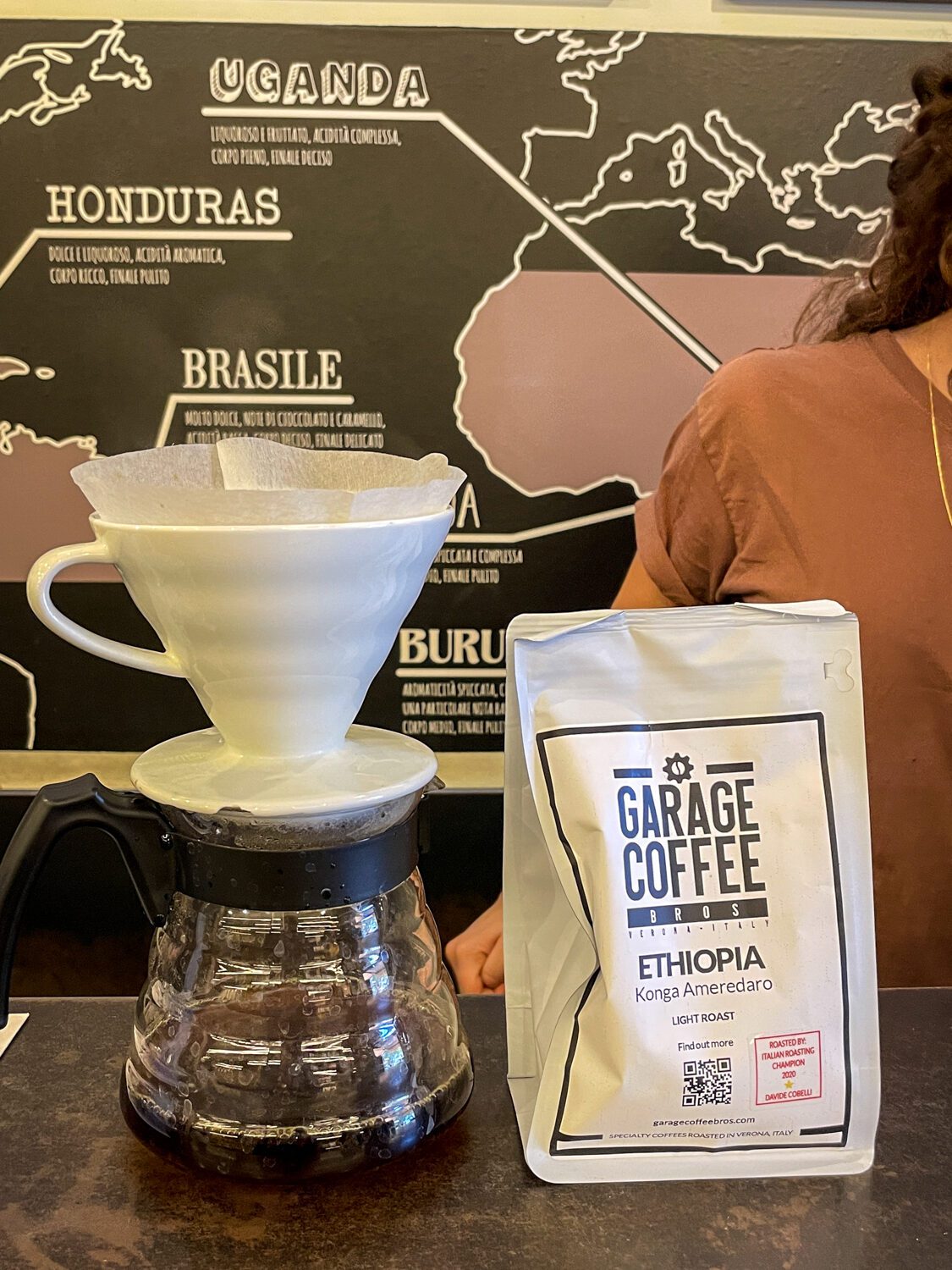
I went here twice on consecutive days, and while the service was initially a little cold (I’d imagine it’s because of all the tourists), once I started asking questions about the coffee (in broken Italian, which we eventually moved over to English), the baristas became much more animated and willing to engage.
They have a menu that features several (four, when I was there) espresso options, including one base option and a few more exciting options from a variety of roasters.
Then they also have a selection of 4-5 filter coffees that can be prepared with a V60 or Aeropress, also featuring a variety of roasters, countries of origin, and processing methods.
I had two shots of espresso across my two visits on this last trip – a natural process Ugandan coffee roasted by Gardelli that was a little funky, a little sweet, and a lot fruity, and a thermal shock Costa Rican coffee under the Pergamino brand (that was roasted by Garage in Verona, who is a friend of the owners).
I will say that on initial impression, the staff here have been downright unfriendly when I’ve interacted with them, but once I started asking questions about the coffees and how they prepare them, they have warmed up a bit.
Be prepared to feel like you’re intruding on their day at first.
However, I also feel like I should mention that their location around the corner from the Vatican makes this make a TON more sense.
I have personally witnessed many people come in without saying a word, using their bathroom, and leaving. Or using their tables outside to sit without ordering anything.
If I had to deal with that, I’d probably be skeptical of tourists too!
Planning a trip to Italy? We’d love to help!
Here are our other Italy travel guides to help you plan an incredible trip (even if you have to eat gluten free!).
If there’s no link below, it means we’re still working on it – long, in-depth guides take time! We’re working on it, though, we promise.
If you’re planning a trip and you’re not sure where to start, your first stop should probably be one of our detailed itineraries.
We have a two week Italy itinerary that blends the main cities with some less-visited cities that we love (BOLOGNA!), a guide to spending 10 days in Italy that focuses mostly on the highlights, and a whirlwind guide to spending one week in Italy that features the Rome – Florence – Venice highlight circuit.
We also have a guide covering important tips for traveling to Italy for the first time, which is a collection of things we’ve learned over the course of our time in Italy that will help you have a smoother, more immersive trip.
Here are more specific guides to the main cities in Italy.
Rome
- What to do in Rome (as a First Timer)
- How to Plan an Amazing 4 Day Rome Itinerary
- Where to Stay in Rome: A Complete Guide for First Timers
- 26 Things to Know Before You Visit Rome
- Gluten Free Rome: A Complete Guide to GF Restaurants + Bakeries
- Where to Find the Best Specialty Coffee in Rome
Florence
- What to do in Florence (as a First Timer)
- How to Plan an Amazing Florence Itinerary (3 Days)
- Where to Stay in Florence: A Complete Guide for First Timers
- Gluten Free Florence: A Complete Guide to GF Restaurants + Bakeries
- Where to Find the Best Specialty Coffee in Florence (for Coffee Nerds)
- The Best Day Trips from Florence (Complete Planning Guide)
Venice
- A Perfect 3 Day Venice Itinerary (for First Timers)
- Exactly What to Do in Venice (As a First Timer)
- Where to Stay in Venice: A Complete Guide
- Gluten Free Venice: A Complete Guide (for Foodies)
Bologna
- What to do in Bologna (as a First Timer)
- How to Spend One Incredible Day in Bologna
- How to Plan an Amazing Bologna Itinerary (2 Days)
- Where to Stay in Bologna: A Complete Guide for First Timers
Cinque Terre
- What to do in Cinque Terre (as a First Timer)
- How to Plan an Amazing Cinque Terre Itinerary (2 Days)
- Where to Stay in Cinque Terre: A Complete Guide for First Timers
Milan
- What to do in Milan (as a First Timer)
- How to Plan an Amazing Milan Itinerary (2 Days)
- Where to Stay in Milan: A Complete Guide for First Timers
- Gluten Free Milan: A Complete Guide to GF Restaurants + Bakeries
The Rest of Italy
